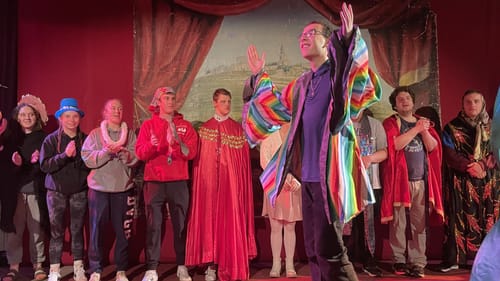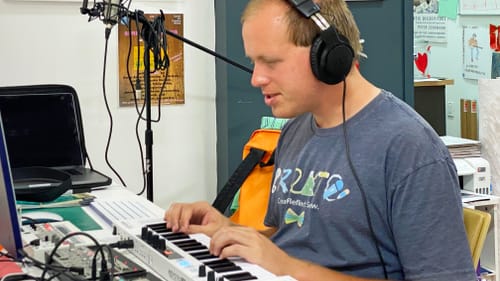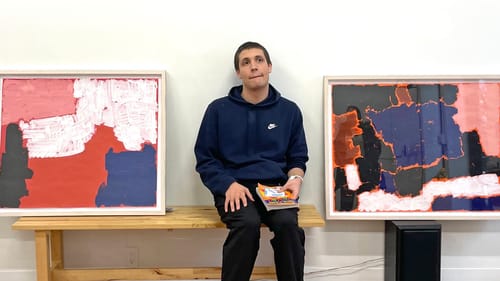Stay in the Loop
BSR publishes on a weekly schedule, with an email newsletter every Wednesday and Thursday morning. There’s no paywall, and subscribing is always free.
What else can theater be?
“A responsibility to open the door”: how do we embrace disability on an institutional level?

Arts and culture organizations face complex decisions about how to disassemble barriers to access and full representation. Some are making bold moves, embracing previously excluded subjects, artists, and audiences. Others prioritize groundbreaking, even provocative, content—some of which happens to be inclusive. We dive into theater in the dark, the no-shush zone, wandering audiences, and more.
We open the door of Bristol Riverside Theatre’s (BRT) rehearsal studio building expecting a lobby, only to find a faux airport lounge. “Welcome to PitchBlack Airlines,” the signs say. Over a loudspeaker, we hear “Flight 243 to Buenos Aires is now boarding,” followed by unusual instructions: all phones and watches must be placed in locked pouches that we may hold but cannot open. We should arrange ourselves into groups of six, grasping the shoulders of the person in front of us. Then, the stewards guide us through blackout curtains into absolute darkness.
Once we feel our way onto chairs, the captain’s voice begins the usual announcements. Over sounds of engine ignition and taxiing, two passengers start a conversation. A performance of Odd Man Out (which ran at BRT in December 2022) has begun. Without a single visual cue, we are immersed in the story of a blind Argentinian musician traveling home from New York City for the first time in decades. The bi-continental narrative is shaped by sounds, smells, cool mists, guitar music, and a scrap of paper with the word “love” embossed in braille.

What else can theater be?
“We all know what the experience of theater looks like,” says BRT’s Ken Kaissar over Zoom alongside fellow co-producing director (and spouse) Amy Kaissar. “You buy a ticket, you enter, you're sitting in a seat that's screwed down … and you’re all looking in one direction. Now, are there other forms? We're constantly interested in what else this could be. If the story is interesting and … opens us up to something, we are likely to do it.”
Amy continues: “Another goal of ours is for more people to see themselves represented on our stage and feel that we offer stories that are relevant for them. But we’re not educators; we make theater.”
The Kaissars chanced upon a showcase production of Odd Man Out in New York City before the pandemic. An Argentinian company called Teatro Ciego (Blind Theater) sought a venue to develop and present the play in the US. Here was an opportunity to create something radically different that was also bilingual with a blind director and low-vision actors. Amy and Ken saw the potential for a unique, immersive theater experience and took the plunge.
Enter the no-shush zone
Hedgerow Theatre’s executive artistic director, Marcie Bramucci, is an outspoken advocate for inclusion, especially for neurodiverse audiences and content. In her previous role as director of community investment at People’s Light, she pioneered the company’s relaxed performance initiative and other inclusive practices. This earned her a 2015 award from Art-Reach, a highly regarded nonprofit whose mission is to ensure arts access for people with disabilities and low-income individuals.
Relaxed performances, which Bramucci calls a “no-shush zone,” jettison norms about audience behavior to provide “the grace and space so people can be their fullest selves.” Individuals with autism, ADHD, dementia, and sensory sensitivities are encouraged to enjoy performances in a “safe, welcoming container.” Vocalization, movement, and assistive devices with screens are not just tolerated but welcomed. Some venues offer fidget spinners for self-stimulation and a nearby quiet room for decompressing.
A ramp by any other name
Bramucci started her work in relaxed performance by speaking to hundreds of people with autism, caregivers, occupational therapists, and teachers. “I really wanted to understand what are the divides,” she says. “Not just about theater, but the everyday divides that folks with disabilities and autism navigate. Many have begun to opt out of public experience entirely. They don't go to the grocery store or the library. They don't even engage as full citizens.”
Bramucci references the wheelchair ramps that became ubiquitous after the 1990 passage of the Americans with Disabilities Act. “What is the ramp for any other area of need? Sometimes, you just need people to understand that if you are vocalizing or moving [in a particular way], this doesn't mean that something is wrong. This might simply be how you engage.”
Bramucci helped found a cohort of regional organizations that offer some relaxed performances in their regular seasons, including Hedgerow, People’s Light, Montgomery Theater, McCarter Theatre Center, Pennsylvania Shakespeare Festival, Theatre Horizon, and Delaware Theatre Company.
Neurodivergent people are already here
According to Bramucci, a surprising outcome of this work—and the casting of actors who identify as autistic in last season’s productions of The Pillowman and The Puzzle—has been the number of theater colleagues who subsequently revealed to her that they are neurodivergent. “You'd be surprised how many people already in theater have invisible disabilities but aren’t empowered to share their perspectives,” she observes, because they don't feel safe or valued.
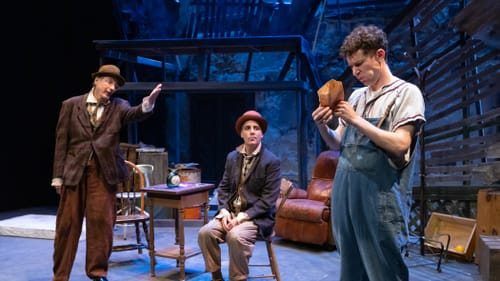
That’s why these different perspectives must be woven throughout the theatrical enterprise, from playwrights and house staff to board members and subscribers: “What are the narratives, and how are we entwining these individuals in every aspect of what we do? That's the goal,” Bramucci says.
Access meets creativity
Collaborations between advocacy/education organizations and arts groups can be vital to successful access initiatives. FringeArts partnered with the Institute on Disabilities at Temple University to present Rhythm Bath in this year’s curated Fringe Festival. FringeArts describes it as “a suite of immersive dance performance-installations developed in conversation and collaboration with neurodiverse communities.” Rhythm Bath was created by Susan Marshall, renowned dancer/choreographer and parent of an “art-loving adult neurodiverse son,” and set designer Mimi Lien, a MacArthur Fellow.
In addition to Marshall and Lien’s iterative development process, dancer Gabrielle Revlock reports that Rhythm Bath offers balloon-like seating that hugs the viewer, and some seats have wheels to facilitate movement. If an audience member enters the performers’ space, Revlock says, the dancers need to quickly recalibrate their positions to preserve the choreography and stay in synch with instructions spoken into earbuds they wear.
FringeArts cofounder and producing director Nick Stuccio smiles when asked how the festival will prepare ticketholders for a performance where people are free to wander. “I chuckle a little bit to think of the things that we've asked of audiences over these 26, 27 years. If they're not ready for [Rhythm Bath], then they don't know us well enough.” All kidding aside, Stuccio emphasizes that the Institute on Disabilities provided essential training to Fringe house staff for Rhythm Bath. “Know before you go” information for audiences is also vital to the success of a relaxed performance approach, according to both Stuccio and Bramucci.
But he adds, “We love … those provocateurs, those artists on the boundaries who are pushing through all kinds of norms, the taboo-busters.” And many of the performers he lists from the FringeArts production history are neurodivergent or disabled.
Partnerships without labels
A vibrant, ongoing partnership exists between Studio Route 29 in Frenchtown, New Jersey, and nearby ArtYard. Studio Route 29 draws on the progressive art studio model, in which artists with developmental disabilities work with the support of staff artists in order to strengthen their techniques and create their own art, which they can exhibit and sell. They learn techniques and create their own art, which they can exhibit and sell.
Jill Kearney, founder and executive director of ArtYard, who helped establish Studio Route 29, says that she loves the way they mix neurodiverse and neurotypical artists without using labels. Many Studio Route 29 artists show their work at ArtYard, and the two organizations collaborate on exhibits, festivals, and other events that Kearney finds “unexpectedly joyful.”
“I always look for ways to bring different communities of people together around the arts as a form of bridging social capital,” says Kearney. “That could be with respect to disability … [or] a whole host of other ways in which people are siloed and disconnected in our culture.”
Currently, ArtYard is showing Evidence, artwork by Natalie de Segonzac, who uses a wheelchair and frequently incorporates what she calls her “injury” in her work. Actor and circus artist Brianna Kalisch is doing an August residency at ArtYard, developing (In)Tangible, a dramatic circus play about her grandmother’s dementia.
“I have a responsibility to open the door to people who are sometimes invisible to the art world,” observes Kearney. “I feel lucky … I can do that. Whenever something is transformational, high-caliber work and opens a door, that’s a trifecta for me. While disability and access are not ArtYard’s sole focus, they are ‘baked into our DNA.'”
Using another biological metaphor, Hedgerow’s Bramucci says, “The work of inclusion in the arts is never really done. It's a muscle we're constantly evolving … as we learn more about each other.”
Did you miss part one of this feature? Find it here.
Editor's note: BSR provides custom alt text for all images posted on our site and accessibility info for all venues we cover. Read more about our accessibility mission here.
Sign up for our newsletter
All of the week's new articles, all in one place. Sign up for the free weekly BSR newsletters, and don't miss a conversation.

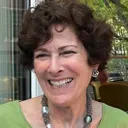 Wendy Univer
Wendy Univer
